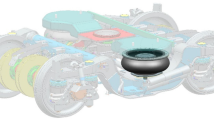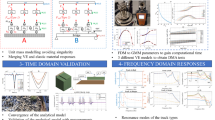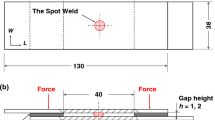Abstract
A thin-walled weak-rigidity blisk blade is constructed from heat-resistant, high-strength materials. It is thus difficult to use conventional processing methods and adapt to blisk-blade deformation (BBD) or inner stress in the manufacturing of a blisk blade, and to guarantee dimensional precision and surface quality. The present research improves the dimensional precision and surface quality by developing constant-load adaptive belt polishing (CABP) for the thin-walled weak-rigidity blisk blade. The paper illustrates the methodology of CABP and establishes an equation for micro-displacement in constant-load adaptive control. The motion mechanism and control model for the micro-displacement are then analyzed and optimized. Dimensional precision is guaranteed because the constant-load adaptive control adapts to the BBD and because the flexible nature of belt polishing avoids deformation in manufacturing. Additionally, a cubic boron nitride belt is used to realize high efficiency and accuracy in the manufacture of a thin-walled blisk blade. Finally, different methods of belt polishing are experimentally investigated to determine a method appropriate for polishing an aero-engine blisk. The experimental results show that CABP has advantages of dimensional precision and consistency of the surface quality over traditional belt polishing when the BBD is large.
Similar content being viewed by others
References
Huang Y, Huang Z (2009) Modern abrasive belt grinding technology and application in engineering. China, Chongqing
Huang Y, Yang JF, Ye XX, Chai H (2014) A belt grinding equipment used for blisk blade edge-R. China, CN2012102340507
Ren JX, Zhang DH, Wang ZQ, Liu WW, Wang WH (2004) Research on the NC machining technique of blisk. Acta aeronautica et astronautica sinica 25(2):205–208
Chen W, Lou P, Chen H (2009) Active compensation methods of machining deformation of thin-walled parts. Acta aeronautica et astronautica sinica 30(03):570–576
Wan M, Zhang WH (2008) Overviews of technique research progress of form error prediction and error compensation in milling process. Acta aeronautica et astronautica sinica 29(5):1340–1349
Rhoades LJ (1988) Abrasive flow machining. Manuf Eng 75–78
Singh S, Shan HS (2002) Development of magneto abrasive flow machining process. Int J Mach Tools Manuf 42(8):953–959
Saleh T, Bishwas I, Rahman M (2010) Efficient dressing of the wheel in ELID grinding by controllable voltage with force feed back. Int J Adv Manuf Technol 46(4):123–130
Shanawaz AM, Sundaram S, Pillai UTS, Aurtherson PB (2011) Grinding of aluminium silicon carbide metal matrix composite materials by electrolytic in-process dressing grinding. Int J Adv Manuf Technol 57(1–4):143–150
Goswami RN, Mitra S, Sarkar S (2009) Experimental investigation on electrochemical grinding (ECG) of alumina-aluminum interpenetrating phase composite. Int J Adv Manuf Technol 40(7–8):729–741
Liu JW, Yue TM, Guo ZN (2013) Grinding-aided electrochemical discharge machining of particulate reinforced metal matrix composites. Int J Adv Manuf Technol. doi:10.1007/s00170-013-4846-8
Puri AB, Banerjee S (2013) Multiple-response optimisation of electrochemical grinding characteristics through response surface methodology. Int J Adv Manuf Technol 64(5–8):715–725
Goetz F, Chow CW, Wang W, Thomas H (2014) Application of vibropeening on aero-engine component. Procedia CIRP 13:423–428
Wolfgang H, Goetz F, Thomas H (2014) Shot peening method for aerofoil treatment of blisk assemblies. Procedia CIRP 13:355–358
Zhao PB, Shi YY (2014) Adaptive sliding mode control of the A-axis used for blisk manufacturing. Chin J Aeronaut 27(3):708–715
Zhao PB, Shi YY (2014) Posture adaptive control of the flexible grinding head for blisk manufacturing. Int J Adv Manuf Technol 70:1989–2001
Duan JH, Shi YY, Li XB, Zhang JF (2011) Adaptive polishing for blisk by flexible grinding head. Acta aeronautica et astronautica sinica 32(5):934
Xu ZY, Xu Q, Zhu D, Gong T (2013) A high efficiency electrochemical machining method of blisk channels. CIRP Annals. Manufac Technol 62:187–190
Liu X, Kang X, Zhao W, Liang W (2013) Electrode feeding path searching for 5-axis EDM of integral shrouded blisks. Procedia CIRP 6:107–111
Xu ZY, Sun LY, Hu Y, Zhang JC (2014) Flow field design and experimental investigation of electrochemical machining on blisk cascade passage. Int J Adv Manuf Technol 71:459–469
Liu J, Xu ZY, Wan LK, Zu D (2014) Optimization and experiment of cathode feeding direction in electrochemical machining of blisk. Journal of Mechanical Engineering 50(7):146–153
Zhu D, Zhu D, Xu ZY (2012) Optimal design of the sheet cathode using W-shaped electrolyte flow mode in ECM. Int J Adv Manuf Technol 62:147–156
Zhu D, Zhu D, Xu ZY, Zhou LS (2013) Trajectory control strategy of cathodes in blisk electrochemical machining. Chin J Aeronaut 26(4):1064–1070
Bremer C (2000) Adaptive strategies for manufacturing and repair of blades and blisks, Proceedings of ASME Turbo Expo 2000: 45th ASME International Gas Turbine & Aero-engine Technical Congress 1–5.
Wu SH, Kazerounian K, Gan ZX, Sun YQ (2013) A simulation platform for optimal selection of robotic belt grinding system parameters. Int J Adv Manuf Technol 64(1–4):447–458
Ren XY, Kuhlenkötter B (2008) Real-time simulation and visualization of robotic belt grinding processes. Int J Adv Manuf Technol 35(11–12):1090–1099
Chen RK (2014) Research on the grinding process of the blisk moulding surface. China, Chongqing
Wei HP (2014) Research on abrasive belt grinding of blisk blade inner and outer profile. China, Chongqing
Liu ZY (2014) Path planning for blisk blade surface belt grinding and spatial axis analysis. China, Chongqing
Huang H, Gong ZM, Chen XQ, Zhou L (2002) Robotic grinding and polishing for turbine-vane overhaul. J Mater Process Technol 127:140–145
Carneiro JF, Almeida FG (2013) Using two servovalves to improve pneumatic force control in industrial cylinders. Int J Adv Manuf Technol 66(1–4):283–301
Taghizadeh M, Najafi F, Ghaffari A (2010) Multimodel PD-control of a pneumatic actuator under variable loads. Int J Adv Manuf Technol 48(5–8):655–662
Author information
Authors and Affiliations
Corresponding author
Rights and permissions
About this article
Cite this article
Xiao, G., Huang, Y. Constant-load adaptive belt polishing of the weak-rigidity blisk blade. Int J Adv Manuf Technol 78, 1473–1484 (2015). https://doi.org/10.1007/s00170-014-6724-4
Received:
Accepted:
Published:
Issue Date:
DOI: https://doi.org/10.1007/s00170-014-6724-4




